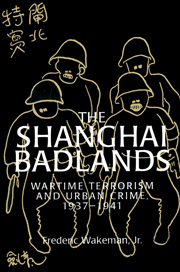Book contents
- Frontmatter
- Contents
- Dedication
- Acknowledgments
- Glossary
- Shanghai, 1940
- Metropolitan Shanghai
- Dedication
- Prologue: Consequences
- 1 Island Shanghai
- 2 Blue Shirts
- 3 National salvation
- 4 Retaliation: Pro-Japanese terrorism
- 5 Provocation: The Chen Lu assassination
- 6 Capitulation: The Xi Shitai assassination
- 7 The puppet police and 76 Jessfield Road
- 8 Terrorism and crime
- 9 Rackets
- 10 Terrorist wars
- 11 Dimout
- Epilogue: Outcomes
- Abbreviations
- Notes
- Bibliography
- Index
6 - Capitulation: The Xi Shitai assassination
Published online by Cambridge University Press: 02 November 2009
- Frontmatter
- Contents
- Dedication
- Acknowledgments
- Glossary
- Shanghai, 1940
- Metropolitan Shanghai
- Dedication
- Prologue: Consequences
- 1 Island Shanghai
- 2 Blue Shirts
- 3 National salvation
- 4 Retaliation: Pro-Japanese terrorism
- 5 Provocation: The Chen Lu assassination
- 6 Capitulation: The Xi Shitai assassination
- 7 The puppet police and 76 Jessfield Road
- 8 Terrorism and crime
- 9 Rackets
- 10 Terrorist wars
- 11 Dimout
- Epilogue: Outcomes
- Abbreviations
- Notes
- Bibliography
- Index
Summary
The assassination of Chen Lu thrilled Chinese patriots, who read about the incident in one newspaper account as a paired literary couplet: “A valiant man descended from the heavens last night. / The collaborator instantly entered his name in the roster of ghosts.” The Japanese, who had difficulty finding a successor to Chen Lu as puppet foreign minister, were predictably outraged. Yet they could not blame the British for failing to guard Chen Lu from harm, because even though Settlement policemen from the Bubbling Well Road station had rushed to the murder scene, the Shanghai Municipal Police quickly discovered that 668/25 Yuyuan Road was an address under the jurisdiction of the Japanese Military Police. Once this was pointed out to the Japanese, all the latter could do was to grumble that the Shanghai Municipal Police had not informed them of the puppet foreign minister's arrival in Shanghai in the first place.
Chinese loyalist attacks and the threat of Japanese intervention
The assault on the same day as Chen Lu's assassination of four Japanese civilians, one of whom was severely wounded, was consequently treated with extraordinary gravity by the Japanese authorities—almost as though it were a surrogate case. The four persons—an official Japanese army photographer (Koyanagi Jiichi), a taxi dancer (Morioka Masako), a man named Sato Rokuo, and another Japanese prostitute—had just lunched at a Chinese restaurant in the Settlement and were about to set off in an antiquated taxicab when a man dressed in Chinese clothes stepped forward and began firing randomly through the car window.
- Type
- Chapter
- Information
- The Shanghai BadlandsWartime Terrorism and Urban Crime, 1937–1941, pp. 65 - 79Publisher: Cambridge University PressPrint publication year: 1996



